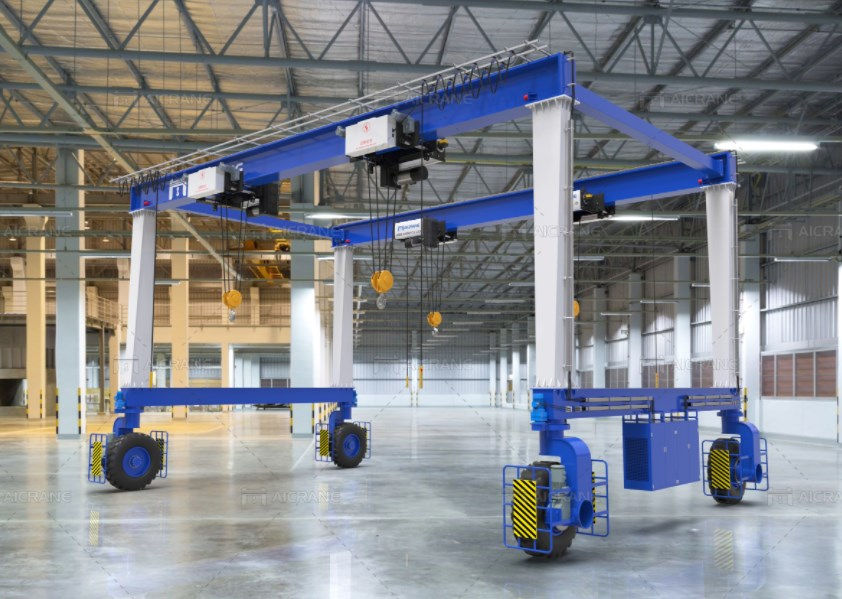The Rubber-Tyred Gantry Crane: An Industrial Workhorse
- charlespsnow
- Nov 2, 2023
- 4 min read
In industrial settings, the efficient movement and handling of heavy cargo and materials are paramount for ensuring productivity and cost-effectiveness. One indispensable piece of equipment that has revolutionized material handling in industries such as shipping, logistics, and manufacturing is the Rubber-Tyred Gantry Crane (RTG). These versatile and powerful cranes have become essential in managing the complex and demanding demands of modern industrial operations. In this article, we will explore the pivotal role of the Rubber-Tyred Gantry Crane in various industrial settings, shedding light on its importance, functionalities, and advantages.
The Basics of Rubber-Tyred Gantry Cranes
The Rubber-Tyred Gantry Crane, commonly referred to as the RTG, is a mobile gantry crane equipped with rubber tires. Unlike traditional gantry cranes, which are typically fixed to a track or rail system, RTGs are mounted on wheels, providing mobility and flexibility in their operation. These cranes are designed for lifting and transporting heavy cargo containers and other materials in industrial environments.

Key Components and Features of an RTG:
Rubber Tires: The most distinctive feature of an RTG is its rubber tires. These tires allow the crane to move in various directions, making it highly maneuverable within a defined work area.
Hoisting Mechanism: RTGs are equipped with a hoisting mechanism, typically with a spreader or hook attachment, for lifting and lowering cargo. The hoisting mechanism is often capable of handling large containers efficiently.
Gantry Structure: The crane's gantry structure consists of vertical legs that provide stability and support the horizontal beam. This structure allows the rubber tyre gantry crane to straddle and lift containers, ensuring safe and precise handling.
Operator Cabin: An operator's cabin is usually located at the top of the crane, providing the operator with a clear view of the work area and advanced control systems for efficient and safe operation.
Advanced Control Systems: RTGs are equipped with advanced control systems that enable precise positioning, accurate load control, and various safety features to protect both the crane and personnel.
Importance of Rubber-Tyred Gantry Cranes in Industrial Settings
Container Handling in Ports and Terminals:
RTGs are the backbone of container handling operations in ports and intermodal terminals. They play a crucial role in efficiently transferring containers between ships, storage yards, and other modes of transportation. Their mobility allows them to handle containers positioned anywhere within the terminal, ensuring rapid and organized cargo movement.
Efficiency in Manufacturing:
In manufacturing facilities, RTGs are employed to move heavy materials and products, streamlining production processes. They are often used to load and unload trucks, organize raw materials, and transport finished goods. The flexibility of RTGs means that they can adapt to the ever-changing layout of manufacturing facilities, making them a valuable asset.
Flexible Warehouse Operations:
Warehouses and distribution centers rely on RTGs for various tasks, such as stacking and retrieving pallets, handling large and bulky items, and optimizing storage space. RTGs can efficiently move goods within the warehouse, minimizing the time and labor required for these tasks.
Increased Productivity:
RTGs are known for their high productivity, thanks to their mobility and precision in material handling. This results in reduced downtime, faster cargo turnover, and increased operational efficiency, all of which are crucial factors in industrial settings.
Space Optimization:
RTGs are particularly valuable in settings where space is limited. The ability to maneuver in tight spaces and stack containers or materials efficiently makes them essential for industries operating in crowded areas or urban environments.
Safety and Control:
RTGs are equipped with advanced control systems that enhance safety by preventing overloading, offering collision avoidance mechanisms, and providing real-time data for operators to make informed decisions. This technology reduces the risk of accidents and equipment damage.
Adaptability to Modern Operations:
As industrial operations evolve to meet changing demands and trends, RTGs have proven to be adaptable to new challenges. Whether it's the growing use of automation or the need for eco-friendly solutions, RTGs can be modified and integrated into a wide range of operational scenarios.
Advantages of Rubber-Tyred Gantry Cranes
Mobility: The primary advantage of RTGs is their mobility, which allows them to reach cargo anywhere within their operating area without the constraints of fixed rails.
Versatility: RTGs can handle a wide range of cargo, from standard containers to specialized heavy loads, making them a versatile choice for various industrial applications.
Reduced Infrastructure Costs: RTGs require less infrastructure investment compared to fixed cranes with extensive rail systems, making them a cost-effective choice.
Quick Setup: RTGs can be mobilized and operational relatively quickly, making them ideal for temporary or changing work environments.
Environmental Considerations: RTGs are available in electric and hybrid configurations, reducing emissions and environmental impact in line with the growing emphasis on sustainability in industry.
Safety Features: The advanced control systems and safety features of RTGs minimize the risk of accidents, ensuring the protection of personnel and assets.
Conclusion
The Rubber-Tyred Gantry Crane, with its mobility, versatility, and advanced technology, has established itself as an indispensable tool in various industrial settings. From ports and terminals to manufacturing facilities and warehouses, RTGs contribute significantly to increased efficiency, reduced operating costs, and improved safety. As industrial operations continue to evolve, RTGs will remain at the forefront of material handling solutions, meeting the complex demands of modern industry and enabling the smooth flow of goods and materials essential for our global economy.










Comments